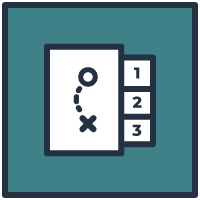Background
A key requirement for state deaf-blind projects is that they “increase the ability of SEAs, LEAs, LAs, EIS providers, and other agencies to use evidence-based practices to improve outcomes for children who are deafblind.” (6, p. 39260) This mandate is consistent with trends in education and other fields, including public health, social work, and medicine, that aim to ensure that practitioners use the best knowledge available when providing services to their students or clients.
The impetus to identify ways to build the capacity of practitioners to use effective practices has led to a rapid expansion of research regarding strategies, resources, and setting characteristics that improve implementation. Consequently, this area of study is often referred to as implementation science (or implementation research). Research into technical assistance strategies that provide ongoing support to practitioners as they learn to implement new practices is an important part of implementation science. (4)
Why This Guide was Developed
Implementation science literature primarily focuses on expanding the use of evidence-based practices for the benefit of large, homogeneous groups of individuals. In developing this guide, our goal was to work with state deaf-blind projects to show how implementation science knowledge is also applicable to TA related to the small, heterogeneous population of children who are deaf-blind. The work of deaf-blind project personnel differs from broader implementation efforts in two ways:
- The work is much smaller in scope, typically focusing on a single team rather than the majority of educators in a school, district, or state. Because deaf-blindness is an extremely severe and complex disability, children who are deaf-blind require highly individualized programming.
- State deaf-blind project personnel serve as external consultants. The vast majority of practitioners in early intervention and educational settings have limited or no training or experience in deaf-blindness, and schools and districts typically lack the internal expertise needed to obtain the knowledge and skills required to implement effective practices for children who are deaf-blind. The current system of deaf-blind projects funded by OSEP was designed to fill this gap.
In developing this guide we relied heavily on preexisting frameworks intended to make implementation science findings applicable to the everyday work of building implementation capacity. The most visible example of this in special education has been through the State Implementation and Scaling-Up of Evidence-Based Practices (SISEP) Center. Funded by the U.S. Department of Education’s Office of Special Education Programs, SISEP was created to “help establish implementation and scaling capacity in state, regional, and district educational systems.” (10)
As part of its work, SISEP has made available numerous modules, lessons, and tools that convey practical knowledge about improving implementation capacity. (8) Although the resources are primarily meant to inform broad efforts that impact relatively large groups of students, many TA providers at state deaf-blind projects have long recognized the value of this information in their work with educational teams that serve a single child. A goal of this guide is to extend that value by linking relevant aspects of SISEP’s model and other resources to strategies that support implementation of effective practices for children who are deaf-blind.
We hope this guide (and a companion guide under development intended to inform systems-change efforts to improve outcomes for children who are deaf-blind) will help the national deaf-blind TA network in the following ways:
- Provide a common vocabulary and organizing principles that enable us to increase our level of collaboration
- Inform our practice so we become more purposeful, structured, and effective in providing TA
- Share and organize resources and tools
- Define how national and state TA intersect
- Help orient new TA providers to the field
- Share what we know to benefit other low-incidence disability disciplines
How this Guide was Developed
Development involved six interconnected activities:
- Literature review (for a list of all of the sources used to date, see References):
- Existing implementation science frameworks
- Other implementation science literature
- Technical assistance literature
- Synthesis of the parts of the literature that apply to deaf-blind TA network activities.
- Solidifying and adapting the information to make it a good fit for the network.
- Augmenting the information with existing tools and developing new tools as necessary (ongoing).
- Creating a web-based product (as well as a printable pdf version) to make the content easily available.
- Ongoing technical assistance to promote use of the information. Current plans for TA include online discussions related to the guide and specific tools, drop-in webinars on TA and implementation topics of interest, and peer-to-peer TA from states that have strong TA delivery systems. Please let NCDB know about the type of TA that would be helpful to you related to topics covered in the guide.
